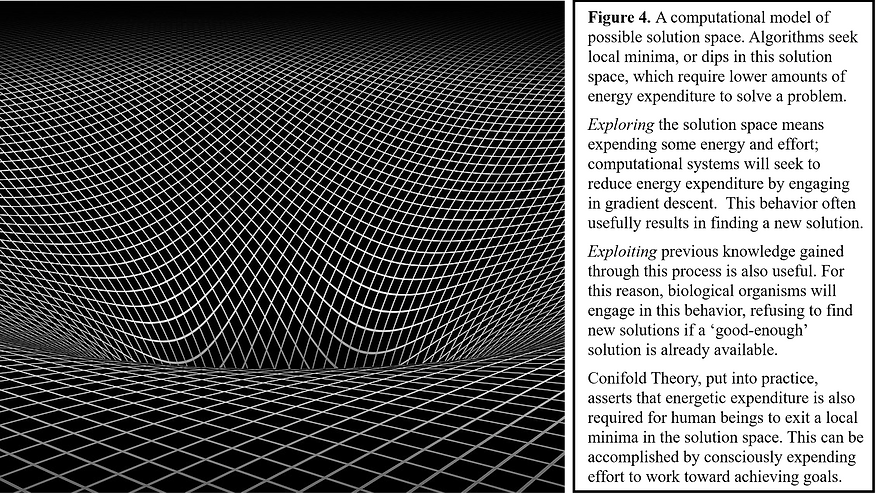Finding a path from previous decisions and unhealthy routines formed in the past
There is a useful analogy in the computing world to explain the dynamic between exploration of the environment and exploitation of previously-gained knowledge. During unsupervised learning, algorithms will explore a space of possibility, which can be imagined as a sort of fabric. Finding a solution to a problem is finding a ‘local minimum’ or dip in this fabric (Figure 4). The algorithm takes steps across the fabric of possible solutions to a problem, and as it does so, it determines whether its own position is entering a dip.
Computationally, the gradient of the dip means that less energy is needed to reach a solution to the problem. And so, in every moment, the algorithm seeks ‘gradient descent’ or lower energy expenditure than was used for the last attempt. The thing about classical algorithms, running on classical computer architecture, is that once they find a solution, they do not willingly expend energy to exit that dip and find another solution. This is why humans are different from computers. We absolutely will explore our environment – trying new things, even challenging things, after we have found a way to get food and other resources. However, we are also capable of exploiting our previously-gained knowledge – sticking to the same routine, continuing the patterns that have already been established, even when we know a better solution is out there. The well-trodden path is difficult to change, because it takes a lot of energy to exit a local minimum.

So how can we maximize energetic efficiency, as biological entities undergoing thermodynamic information processing? Maintaining a nutritious diet, restful sleep, and regular exercise is necessary for effective information processing, but these contributing factors are not sufficient. In order to compute data efficiently, any biological or engineered system must have functioning hardware. After all, it is impossible to ride a bicycle when the gears are stuck. For the human brain, functional hardware means having working ion channels in the neural membrane and efficient enzymes which produce all the molecular materials required by neurons to do their jobs. If these protein structures are altered, due to mutations in the genome, or if they are not present in sufficient amounts within neurons, due to changes in gene expression, then neurons may not be able to send messages to each other effectively. A loss of coordinated activity, due to biological impairments in signal processing components, may in some cases be corrected with pharmacological intervention.
Consciousness is about computing information effectively, and that means putting the neural circuitry to work, actively choosing how best to expend energy in order to meet our goals. There is no shortcut – we have to do the work. In practice, that means deciding how to distribute our energy. Will we explore our environment and entertain new ideas, new ways of being? Or will we continue down the well-trodden paths we have already constructed, regardless of how well these strategies have worked in the past? We can choose whether we will expend energy to gather new information - trying out new behaviors and new ways of interacting with the world - or whether we will save our energy by sticking to known paths and solutions that have led us this far.
On occasions when the structure and operation of the brain makes it extremely difficult to forge new paths – because the energetic expenditure is so great – people may benefit from pharmacological intervention to help them rewire their brains. Modifying the physical neural circuitry can help people to change their thought patterns and behavior. In combination with willingness to change and a great deal of effort, these interventions can make it a bit easier for people to overcome addiction, depression, anxiety, and disorders of perception. But there is a great need for caring, dedicated, professional therapists. Having someone there to share the load, to guide the careful reconstruction of mental models, helps to thermodynamically favor mental and behavioral change. And that's what therapy is, in the view of Conifold Theory - it is a physical process of helping someone change who they are, helping someone perceive the world more effectively, and helping someone to create meaning and purpose in the world through conscious action.